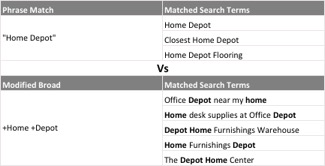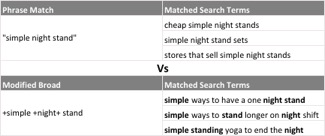When You Need To Have The Right Words Use Phrase Match

In early 2014, I wrote a post at a previous agency that outlined the proper way of breaking out match types that I had started to implement with some fellow colleagues once enhanced campaigns came out the prior year. After the initial creation of these campaign types, I continued to optimize and create a larger strategy around match type segmentation including how to strategically build negatives to make sure there was no overlap across keywords.
Since then, this strategy has translated across the industry to multiple approaches, including segmenting at either the campaign or ad group level and building out each theme and match type to improve the performance of those keyword themes. This allows for specific ad copy that includes each keyword, and as I mentioned previously, a negative strategy across the ad group and campaign level to keep from terms showing in multiple ad groups.
The area that continues to be disputed is the use of phrase verse modified broad match. Modified broad works as a limited broad match and therefore includes the phrase match within that keyword type. Therefore, limiting the number of keywords needed across themes. This is a great strategy for non-brand terms, but phrase match is still required for brand terms and even some non-brand terms that can have multiple meanings depending on the phrasing and order of the words.
[bctt tweet=”Phrase match is still required for brand terms and even some non-brand terms that can have multiple meanings.” username=”michaelaknight”]
Phrase Vs Modified Broad Match
Brand Terms
Let’s look at a quick example of why we would use phrase instead of modified broad match for brand terms. In this example, we are looking at a brand name that also correlates to non-brand products, making it especially necessary to have the use of phrase match instead of modified broad.

Let’s also take a look at a well-known brand where one would think modified match would be OK, but when we do some digging, the term can show up for several unrelated brand searches or competitor searches that should be segmented into their own ad group and campaign.

As we can see from the examples, they show that the phrase match only includes phrases that might show for the terms that are relevant, while the modified broad match shows both relevant and irrelevant searches that are directed at non-brand terms – some matching other brands completely.
Non-Brand Terms
This same strategy of using phrase vs modified broad can also be utilized for non-brand terms, but goes into a deeper discussion around ad group theming. The overall premise for using phrase match instead of modified broad is the same as brand, but also includes the tactic of keywords being grouped into tighter, two or three word themed ad groups, leaving little room for interpretation like modified broad. Thus, creating easier performance reporting and optimization of each term.
An example of a non-brand term that could bring up many interesting queries in a modified broad match vs a phrase match are below:

Again, “simple night stands” in phrase match gives us queries that are directly related to what we want to sell, whereas the modified broad version gives us many unwanted search queries that lower our CTR and relevancy, therefore lowering quality scores. It also can increase wasted spend for those keywords and requires a much larger negative keyword strategy, which in turn creates more work that could have been avoided.
Conclusion
With these examples and the strategy of utilizing phrase match, it does come down to specific account needs and their respective themes. Sometimes using only phrase and exact match can overly limit traffic, as well, so choosing the match types or variety of match types based on account needs are continually important.
The goal here is to create conversation and show examples for why using phrase match for brand terms (plus some non-brand terms) is still a needed match type, based on the products and/or services being advertised.
When creating brand campaigns, continue to think about using phrase match terms to only show brand names for brand searches and about the different ways non-brand terms could be brought up by using those variations of modified broad.



